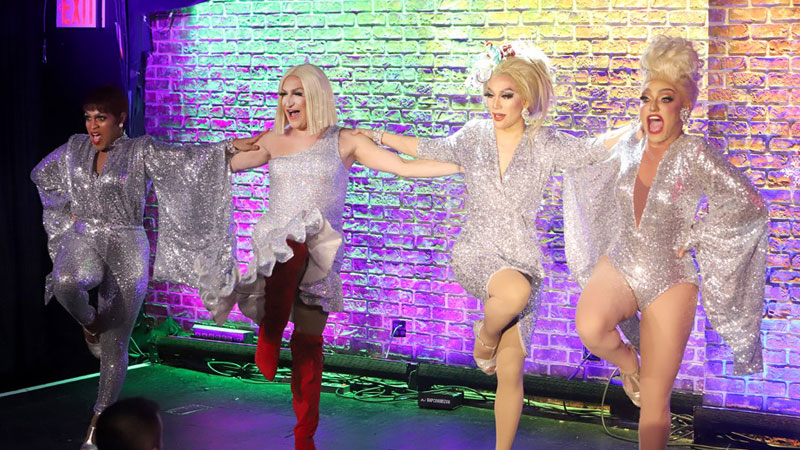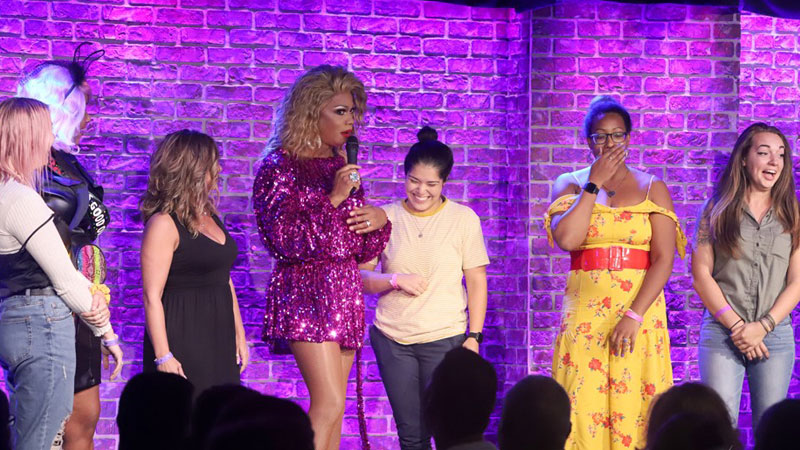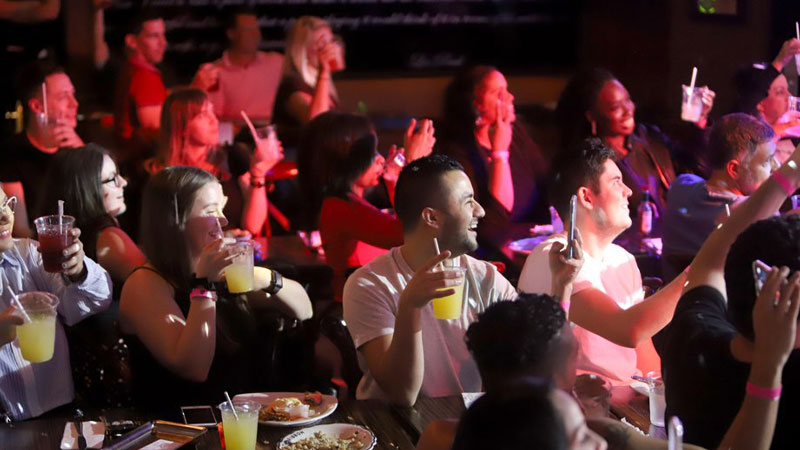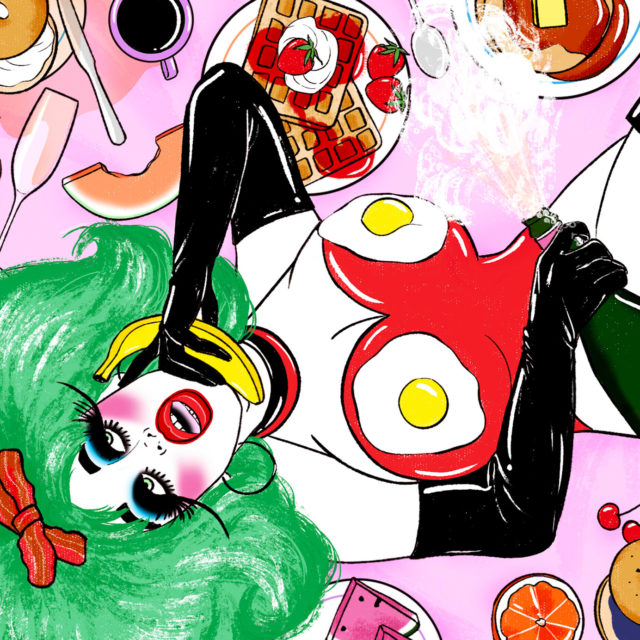In April 2016, drag queen Ritzy Bitz received a message on social media from Voss Events warning her that a popular show she hosted would have to change its name. Voss Events, run by the notorious Brandon Voss, in the years before sending ominous threats had become one of the leading production and marketing companies for LGBTQ talent. The burgeoning brand is widely considered a pioneer of world tours and media blitzes for top-level drag artists — something that would have been inconceivable only a decade ago before the rise of RuPaul’s “Drag Race.” Having conquered nightclubs and global nightlife, Voss was setting its sights on a new territory: brunch.
“When it was first drawn to my attention [they told me] something like, ‘Hey, we’ve trademarked Drag Brunch, can you stop using that on your advertisements?’ And I thought that was pretty aggressive — but whatever. I understand. I thought: I’m doing brunch locally, but they’re doing brunch globally,” says Bitz. “I also laughed because they had only made the trademark just weeks after I had been joking about making my own trademark for Drag Brunch. It could have been me. I took it as a challenge to personalize my show and not just call it Drag Brunch.”
Indeed, Voss had trademarked the phrase “drag brunch” in 2018, but for some reason news of their menacing forewarning went viral much later, in December of 2019. The old news suddenly sparked ire from local drag talent in New York and beyond. It seemed pretty obvious that Voss’s tactic was largely unenforceable on a legal level, but many were stunned by the audacity of the move.

Pariah Sinclar, a self-described “up-and-coming housewife” who runs a drag brunch at Of Love And Regret in Baltimore, felt that Voss was going against the true spirit of drag with this strategy.
“That’s so ridiculous!” said Sinclair. “It’s the opposite of what drag is: Drag, in its essence, was about civil rights. It was about sticking up for what you believe in — and now, these people are just trying to make themselves into a monopoly.”
The Voss situation remains unresolved. (A request for comment from Voss Events was not returned.) At least one brunch provocatively changed its name in hopes of triggering litigation, but nothing resulted from the rebranding.
Economic Opportunity
The struggles that have played out around something as seemingly innocuous as brunch are a microcosm of bigger dynamics within the LGBTQ community. As drag becomes an increasingly mainstream art form, performers will have to decide if their shows are art or just another form of money-making entertainment: Is drag a creative and generative exploration of gender identity, or are drag performers just gender jesters for hire? Brunch has become the strange stage on which this battle now plays out.
It’s hard to say exactly when the popularity of drag brunch really intensified. The tradition had certainly existed on a smaller scale in gay bars or small-scale, queer-owned restaurants before “Drag Race,” but its rise in ubiquity quite clearly coincides with the show’s massive and growing popularity.
Svetlana Stoli, a drag performer who manages the legendary Lucky Cheng’s drag brunch in New York City, says that “it really started slowly growing in 2016. In 2018 and 2019 there was a real explosion. Last summer almost everyone started throwing it out there. It was ‘Drag Race’s’ move to VH1 that really got restaurants interested.”
Thotyssey, a website that shares info about drag events in New York, now lists approximately 20 separate drag brunches hosted in the five boroughs every weekend at both queer-owned and -operated venues and in spaces that otherwise have no connection to the LGBTQ community.

Until rather recently, the idea of seeing drag outside the confines of a gay bar was unheard of. Drag performances were necessarily held in nightlife venues — largely because being seen in drag essentially magnetized hate crimes. LGBTQs survived by hiding their lives in literal darkness. Drag events, like ballroom competitions, started so late because the performers were quite frequently sex workers coming from other jobs. But as drag has moved from a denigrated art form into art galleries and beyond, the medium is now being seen by the light of day — although there’s widespread disagreement within the community as to whether drag makeup looks good in sunlight.
As drag no longer only exists after midnight, suddenly hoards of new audiences are being drawn to the art form now that it’s more accessible. Like RuPaul’s “Drag Race,” drag brunches often appeal to audiences of straight women from a variety of economic backgrounds. Private drag brunches have become chic events for the hyper-wealthy, as seen in several episodes of “The Real Housewives” franchise. In fact, drag brunch has become so lucrative that some performers, like Ritzy, no longer work at nightclubs at all.
“Brunch is becoming the new gay nightlife,” she says. “I was able to survive working brunch and only brunch as my only gig for three years. And for the first two years that was only Sunday!”
Katrina Colby, a drag performer who works brunches at City Tap in Washington, D.C., and Red Star in Baltimore, says she sometimes makes close to 10 times as much money at a brunch than she would working a gig at night.
“For brunch shows I make anywhere from $150 to $1,200 dollars. A night-time show is somewhere between $30 and $150, but it really doesn’t get much past that,” says Colby.
Is Nightlife Over?
Considering the immense labor issues that drag performers are up against to this day, these kinds of earnings represent newfound freedom for artists who would otherwise likely be relegated to lives of poverty and strife. And it’s not just the queens who are making bank. The bars and restaurants themselves are raking in considerable profits from these events. Ethan Ashley, a manager at Nellie’s Sports Bar in Washington, D.C., broke down the numbers:
“Drag brunch is our bread and butter on weekends,” he says. “It makes up to $20,000 if we sell out. It depends a bit on how much people are drinking” during the two rounds of brunch seatings on any given Saturday. Compare that to a Monday night, which Ashley says is their slowest day of the week: “We would normally do like $2,000 or $3,000 on that night.”
Ryan Overberg, a manager at Therapy in New York City, didn’t offer specific estimates of profits, but agreed that brunch is a boon to his business, essentially adding a full night’s worth of profits to the week: “It’s an expensive thing to put on because it’s one of our biggest shows,” Overberg says. “It can sometimes be the equivalent of a really great Thursday night. It’s not quite [as profitable as] a weekend night, but we do well. … We’ve been sold out for the past two months.”
Many drag performers think that an added bonus of drag brunch is getting to act as ambassadors for the queer community, in that a lot of drag-brunch audiences may have never seen drag before. Because drag has become so commonplace — perhaps even oversaturated — within the gay community, some artists relish the opportunity to finally showcase their talents in front of audiences who show actual enthusiasm.
“Gay men are so fucking judgmental, you know this!” says Sinclair. “The straight, drunk women are easier to entertain. You don’t have to do as much to get their money. Gay men expect more because they go to shows regularly. … I appreciate drag brunch because it allows me to reach people who’ve never seen a drag show in their lives.”
“If you’re doing drag brunch you have to cater to a straight crowd,” Colby concurs. “But they appreciate you more. I don’t really like working for gays anymore unless the check is high-dollar. Gays couldn’t give a fuck less. Gays don’t come out to the gay bars anymore anyway, because they don’t — excuse my language — need to find dick at a bar anymore. Night shows are becoming more and more obsolete.”
Drag As Art
But a growing contingent of drag performers is increasingly critical of the drag brunch industrial complex. Because drag has traditionally served as a conduit of community healing or as a political act of gender transgression, many younger and anti-capitalist queers are questioning the assimilationist strain of drag brunch as a practice: If drag had been the artistic medium through which many queers found political liberation, what does it mean that drag is now becoming entertainment for predominantly heterosexual audiences? Can regurgitating heterosexual pop culture for heterosexual crowds even be considered an act of resistance or defiance — even if it serves an ambassadorial purpose? Does drag need to have artistic aspirations at all, or is earning a living enough of a goal for drag performers?

Qhrist With a Q, a New York-based, non-binary drag performer, was deeply critical of what they see happening in the scene.
“It’s very hard for people to take [drag] seriously or give it any kind of respect as an actual art form,” Qhrist says. “It’s very hard for us to get out of bars and to be recognized as anything other than low-stakes, lowbrow, drunk entertainment. And brunch is already this stupid, cosmopolitan, urbanite thing — it’s just this frou-frou, gentrified, bougey thing. The best you can hope for is that it’s a really good racket. Drag brunch is the equivalent of if you want to be a real writer but the best you can hope for is writing product descriptions for a website.”
“I think of what I do as a form of self-expression,” Qhrist continues. “Drag is kind of special to me. I want me doing it to be an opportunity to connect with people that I care about, for us to share a space, and to have fun. I’m doing it for myself. But I guess I’m an outlier in that way — because of ‘Drag Race’ and all of these brands and corporations clamoring to get a cut of the drag pie.”
Another fear expressed by both Qhrist and Pariah was that the drag brunch would eventually go the way of jazzercise, Beanie Babies, and Furbies — that it’s simply a faddish bubble that will eventually burst, potentially leaving many unemployed or under-employed.
“We’re all going to look back and say, ‘God, remember drag brunch? Remember when everyone wanted to go to fucking drag brunch?’” Qhrist moaned sarcastically.
Brunch Beyond the Binary
In scanning advertisements for endless drag brunches, it’s rare to see performers outside the gender binary. What’s more common is a kind of traditional or conservative drag defined by high glamour and feminine glitz.
“It’s limiting,” explains Sinclair. “If you’re more of a club kid, or if your drag is not really what is considered mainstream or conventional — some drag performers don’t want to be a woman! — that’s a little more difficult to sell at a brunch.”
But if drag brunch has become unfriendly to those outside of the binary, to what extent is this genre of drag reinforcing gender stereotypes rather than subverting them? To what extent are bar owners just ruthlessly capitalizing on the newfound popularity of LGBTQ culture? These were precisely the questions Velma Blair had in mind when she started running the midnight drag brunch at AllWays Lounge and Theater in New Orleans.
“Most drag brunches are just commodifying queer culture,” says Blair. “A lot of people producing [drag brunches] don’t really have any stake in the drag community — they’re trying to do something that will make them money. The people there just think it’s a funny thing to do — they aren’t there for the artistry of it. It’s very entry-level, basic, non-threatening drag. In some ways it can approach the queer equivalent of a minstrel show? … With the midnight drag brunch I try to give audiences something more diverse, and for the brunch aspect I try to focus on queer food vendors that do pop-ups in town so that I’m able to support local businesses at the same time.”
Like Velma’s event, it’s slowly becoming more common for “alt” drag performers to create their own drag brunches — like the recently announced “Manmosa” show, a drag king showcase in Queens, N.Y. Whether these events will also begin to attract heterosexual onlookers as their main source of income remains to be seen.
Although there’s something inherently silly about drag brunch, the new paradigms that are playing out at these showcases represent bigger struggles for the queer community as LGBTQs are increasingly considered “normal” in the First World. Can the queer community retain its sense of individuality and identity, or will it increasingly bend to the whims of heterosexuals who continue to exert control over our civil rights?
